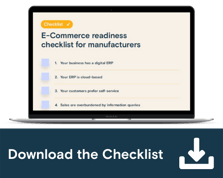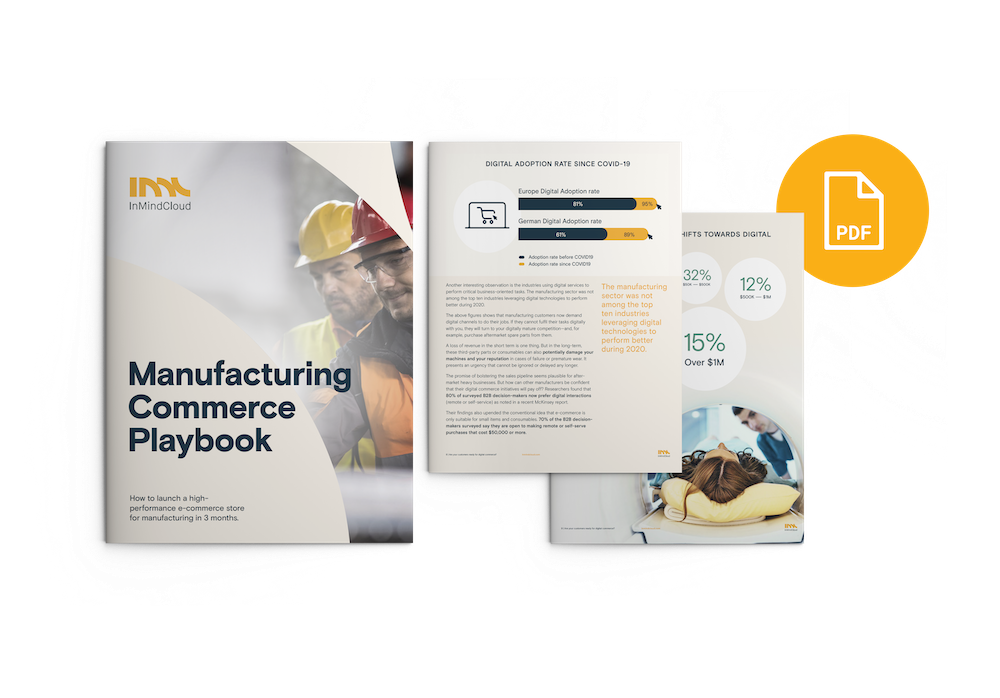How to launch a high-performance e-commerce store for manufacturing in 3 months
Introduction
We are living in the Age of the Customer. Consumers—and that includes your B2B manufacturing customers—have more influence over the buying process than ever before. Increasing global competition and the opportunities of Industry 4.0 are the foundation of the new digital economy your business operates in.
The result? A faster, more competitive offer for equipment, spare parts, or consumables is always just a few clicks away. Your customers are in constant pursuit of growth, revenue and speed. Manufacturers who meet customer demands will be able to secure market share, customer loyalty and access unprecedented growth opportunities.
Table of Contents - Shortcuts
The B2B buying journey in Manufacturing is complex
Why should manufacturers invest in digital commerce?
Are your customers ready for digital Commerce?
Is your manufacturing business ready for digital Commerce?
Checklist: E-Commerce readiness
E-Commerce is paying big dividends for manufacturers
Top 6 Benefits of having an e-commerce storefront for manufacturers
- Spotlight on new areas of revenue
- Accelerate speed-to-market
- Focus on customer experience to improve top-line growth
- Efficiency improvements across the business
- Potential to scale with growth opportunities
- Accurate forecasting with advanced analytics
Checklist: Essential e-commerce features for manufacturers
- Is it purpose-built for manufacturing with tight integration with your ERP?
- Does it have the right capabilities out-of-the-box?
- Is it built in the cloud and delivered online as Software-as-a-Service?
- Has it been designed to fully enhance the user experience?
Top 3 tips to prepare your business for digital commerce
- Adopt next-generation ERP systems to meet business requirements
- Use integrated Software-as-a-Service to enhance business speed and agility
- Assemble a dedicated e-commerce team to ensure digital initiative success
How to get up and running in 3 months (or less)
Case Study: How Satisloh uncovered a goldmine with digital commerce
Conclusion: Meet your customers where they are
The B2B buying journey in Manufacturing is complex

The B2B buying journey is becoming increasingly complex—and decreasingly linear. Buyers of manufacturing solutions need to conclude a series of tasks—both offline and online—before they can buy successfully. To understand your customer’s point of view, you need to realize there is now an average of 6.8 other stakeholders from various departments involved in the entire journey.
Complexities, error risks, and delays at each buying journey touchpoint can result in a substantial loss for both the buyer's and the supplier's business. For a customer, not being able to purchase the right equipment, spare part, or consumables can cause a stoppage in the business or missed opportunities that drain revenue.
For a manufacturer, the impact of errors, delays, or even loss of business is just as devastating.
When a business is difficult to buy from, all parties may miss out on significant bottom and top-line revenue.
In a recent Gartner survey, 77% of B2B buyers reported facing complex buying journeys in their latest purchase. In 2020, the global COVID-19 pandemic added a layer of complexity for buyers. It accelerated digital B2B Commerce by at least five years—both for customers and manufacturers.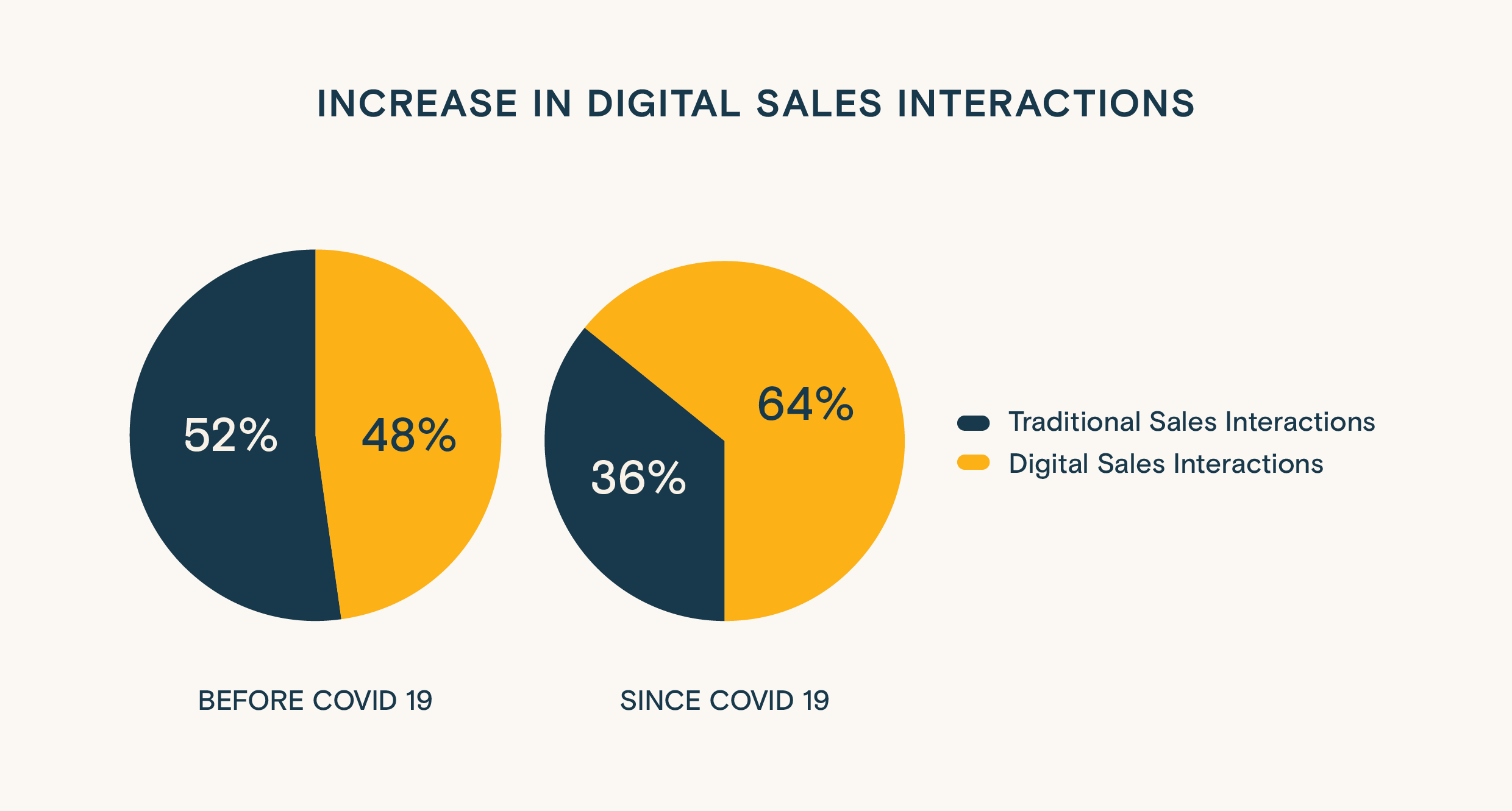
Before the pandemic, customer preference between traditional and digital sales interactions was evenly split. Since the pandemic, the preference for digital interactions surged to 66%. That can only mean one thing.
The future of Manufacturing Commerce is here now. And your business needs to keep up or get left behind.
Why should manufacturers invest in digital commerce?
No matter how loyal they may seem, customers are seeking a better way to buy. Businesses that delay their e-commerce initiatives risk losing out when their customers look for alternative channels.
- 69% of buyers want omnichannel and multichannel services
- 61% of all B2B purchases start with online research
- 67% of B2B purchases are influenced by digital channels
- 58% of B2B buyers start the buying journey with online product search
Today, your customers are increasingly using digital channels for purchasing. Research shows that buyers who have experienced a positive digital experience are 2-8 times more likely to purchase from that business again. If your business is not there to meet them at their preferred channels, your competitors are more than happy to fill in the gap.
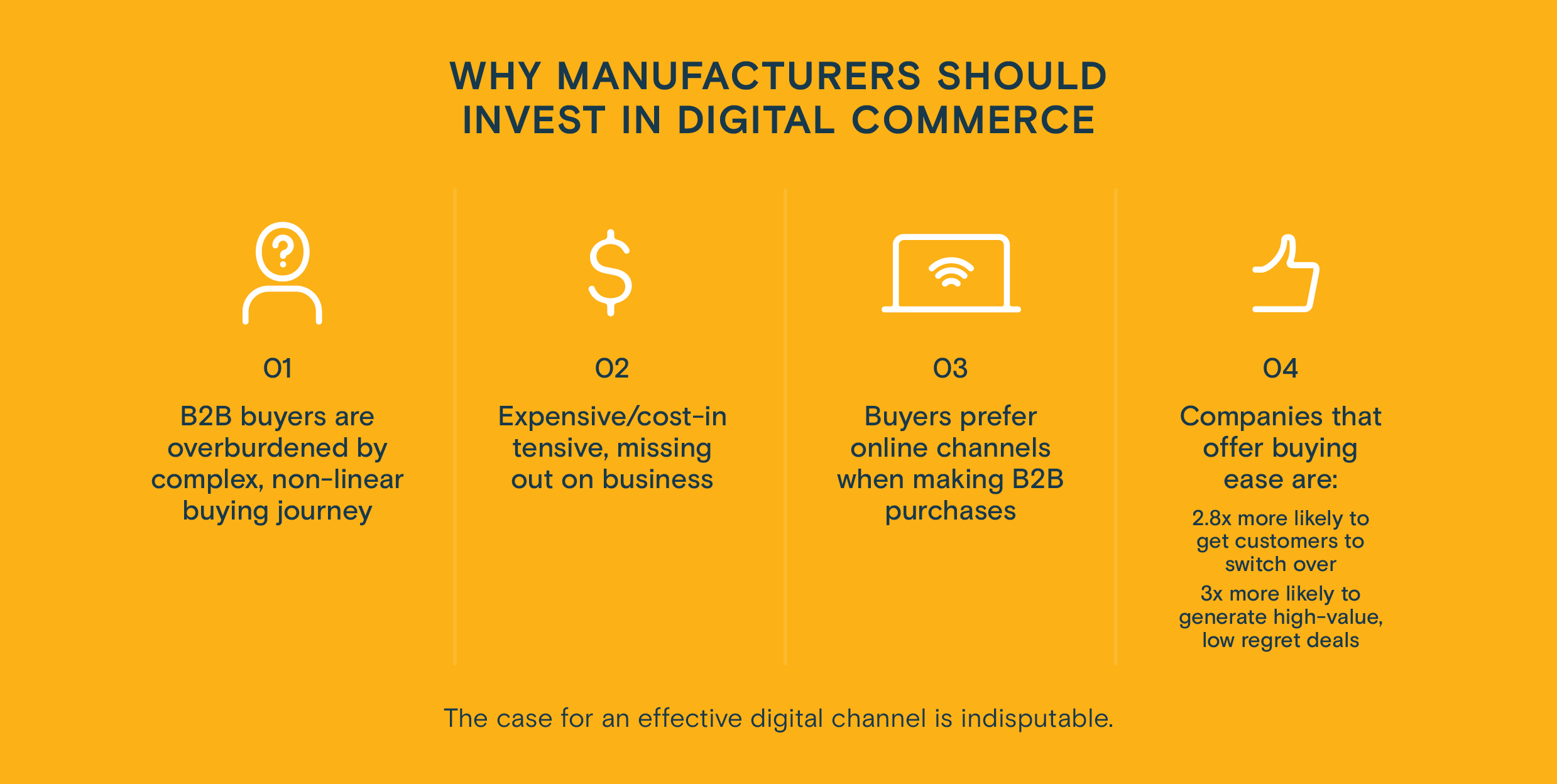
The case for an effective digital channel is indisputable. The question that remains is what’s holding back your digital commerce initiatives and how can you overcome them?
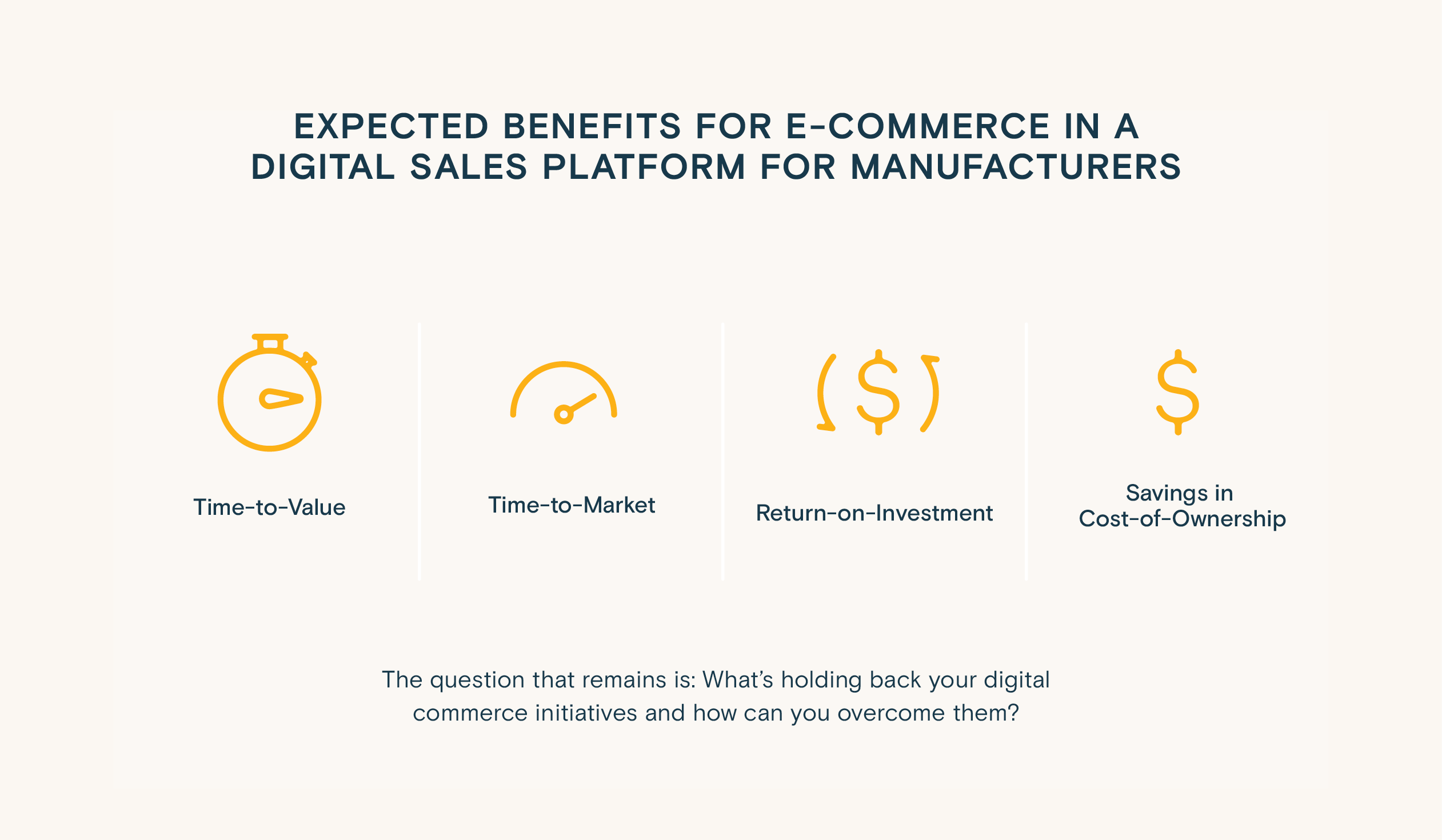
Are your customers ready for digital commerce?
Yes, and they’re crying out for it. Leading businesses today are transforming their sales process to cater to Millennials. 73% of Millennials have matured into buying or even decision-making roles.
They are digital-native, highly educated, and search out additional information before making a purchase decision. They’re also far more likely to make a transaction online rather than over the phone.
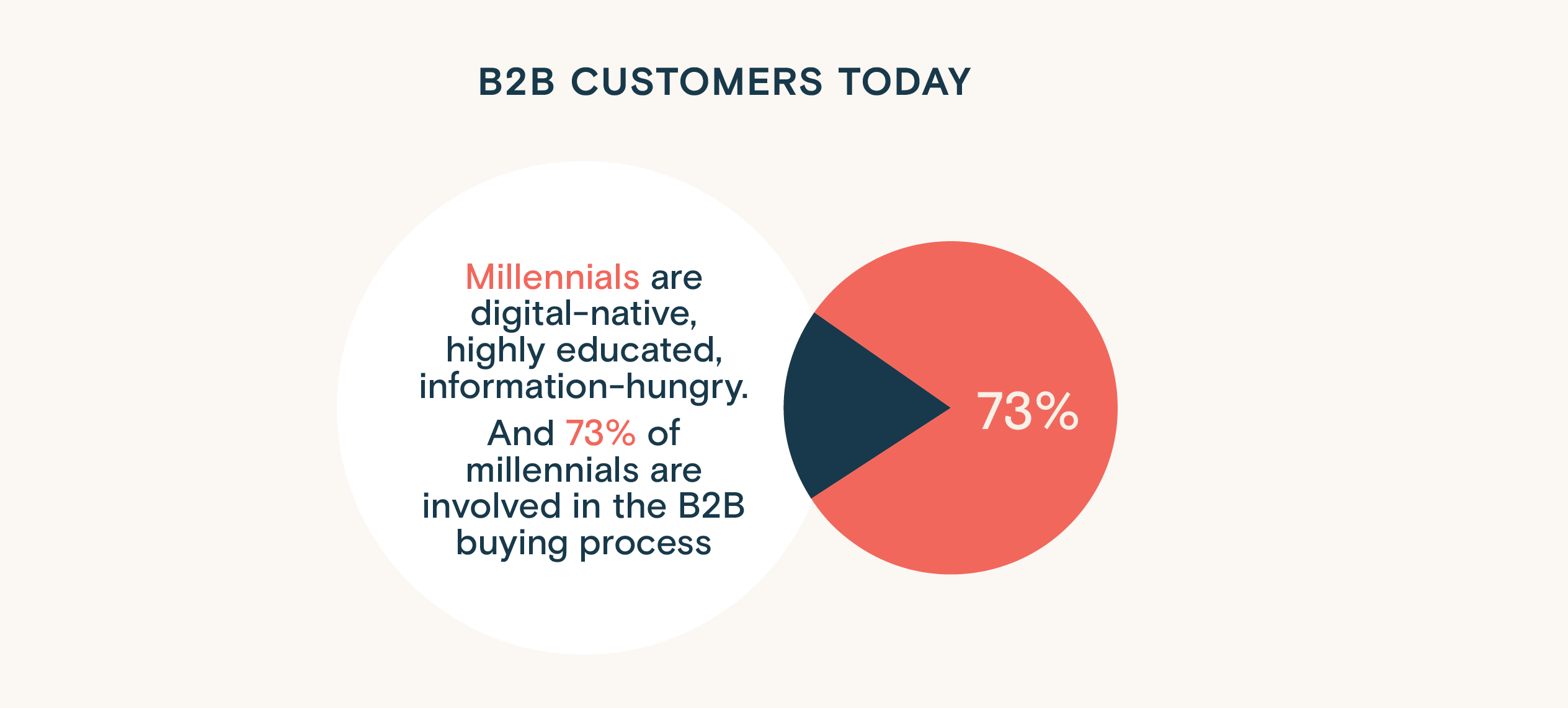
What does that imply for B2B businesses? It indicates that even before COVID-19, the need for customer-centric thinking has been rising. Manufacturers ignoring this trend are losing untold customers, market share, and revenue.
Your customers are increasingly driven by digital. If you’re not focusing there, you can’t know just how much you’re missing.
They have adapted to the new digital norm. In a 2020 McKinsey survey, digital adoption in Europe leaped from 81% to 95%. According to McKinsey, this rise would have traditionally taken 2 to 3 years, but the COVID-19 crisis accelerated it to months.

Germany—which saw the lowest digital adoption rates before the pandemic—saw the highest increase of 28% in digital adoption. Another interesting observation is the industries using digital services to perform critical business-oriented tasks.
The manufacturing sector was not among the top ten industries leveraging digital technologies to perform better in 2020.
The above figures show that manufacturing customers now demand digital channels to do their jobs. If they cannot fulfill their tasks digitally with you, they will turn to your digitally mature competition—and, for example, purchase aftermarket spare parts from them.
A loss of revenue in the short term is one thing. But in the long-term, these third-party parts or consumables can also potentially damage your machines and your reputation in cases of failure or premature wear. It presents an urgency that cannot be ignored or delayed any longer.
The promise of bolstering the sales pipeline seems plausible for after-market heavy businesses. But how can other manufacturers be confident that their digital commerce initiatives will pay off? Researchers found that 80% of surveyed B2B decision-makers now prefer digital interactions (remote or self-service) as noted in a recent McKinsey report.
Their findings also upended the conventional idea that e-commerce is only suitable for small items and consumables. 70% of the B2B decision-makers surveyed say they are open to making remote or self-serve purchases that cost $50,000 or more.
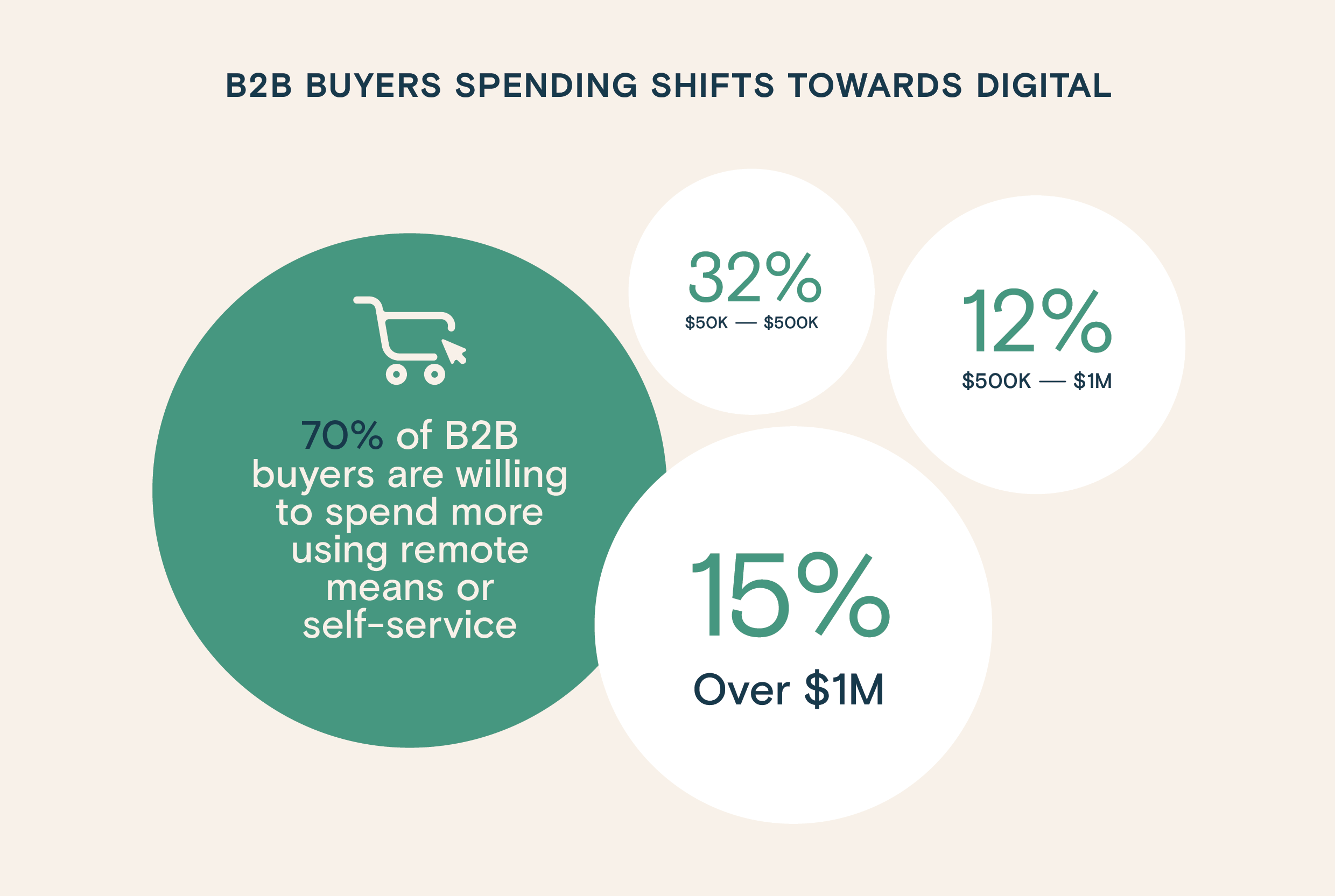
This change in perspective towards e-commerce shows that B2B buyers demand the same frictionless buying, transparency, and convenience from their suppliers. And there is no reason why manufacturers are unable to meet this demand. Here's an example of what effortless buying for manufacturing customers can be like.
This change in attitudes towards e-commerce means that B2B buyers demand frictionless buying, transparency, and convenience from their suppliers. There is no reason why manufacturers cannot meet these expectations. |
Is your manufacturing business ready for digital commerce?
The good news is that most manufacturing organizations are ready for a cutting-edge e-commerce platform—one offering an end-to-end experience that’s on-par with what Amazon offers consumers, or even better. So, how can manufacturers create a remarkable customer experience?
The answer is simple. With the help of your primary advantage—the organization's digital backend. Often referred to as an ERP (Enterprise Resource Planner), such a system becomes the core system of the entire business. As a manufacturer, your ERP manages everything from financials to procurement, production, costs, prices, and logistics.
It has the potential to allow your direct sales, partners, or distributors to unify and customize the entire buying experience. It can help manage the minutia—like the type of screws needed or the matching viscosity of a consumable. In essence, your ERP contains all the information required to take your sales to the next level.
Manufacturers are driving ERP adoptionThe ERP market is expected to exceed $49.5 billion by 2024. 54% of IT decision-makers who responded to a Computer Weekly survey place the digital ERP as a top IT investment priority. Today, manufacturers are the number one users of a digital ERP system. An ERP is critical for manufacturers, and it contains all the data needed to run the business—including sales. |
While an ERP is a critical system for manufacturers, it needs to be paired with a made-for-manufacturing digital commerce solution. Together, your e-commerce shopfront (or customer/partner portal) becomes a powerful revenue-generating hub. Such a hub empowers your customers with 24/7 access to your business. It allows them to send inquiries, get product and service information, contact you, and ultimately buy from you—all through a single-channel experience
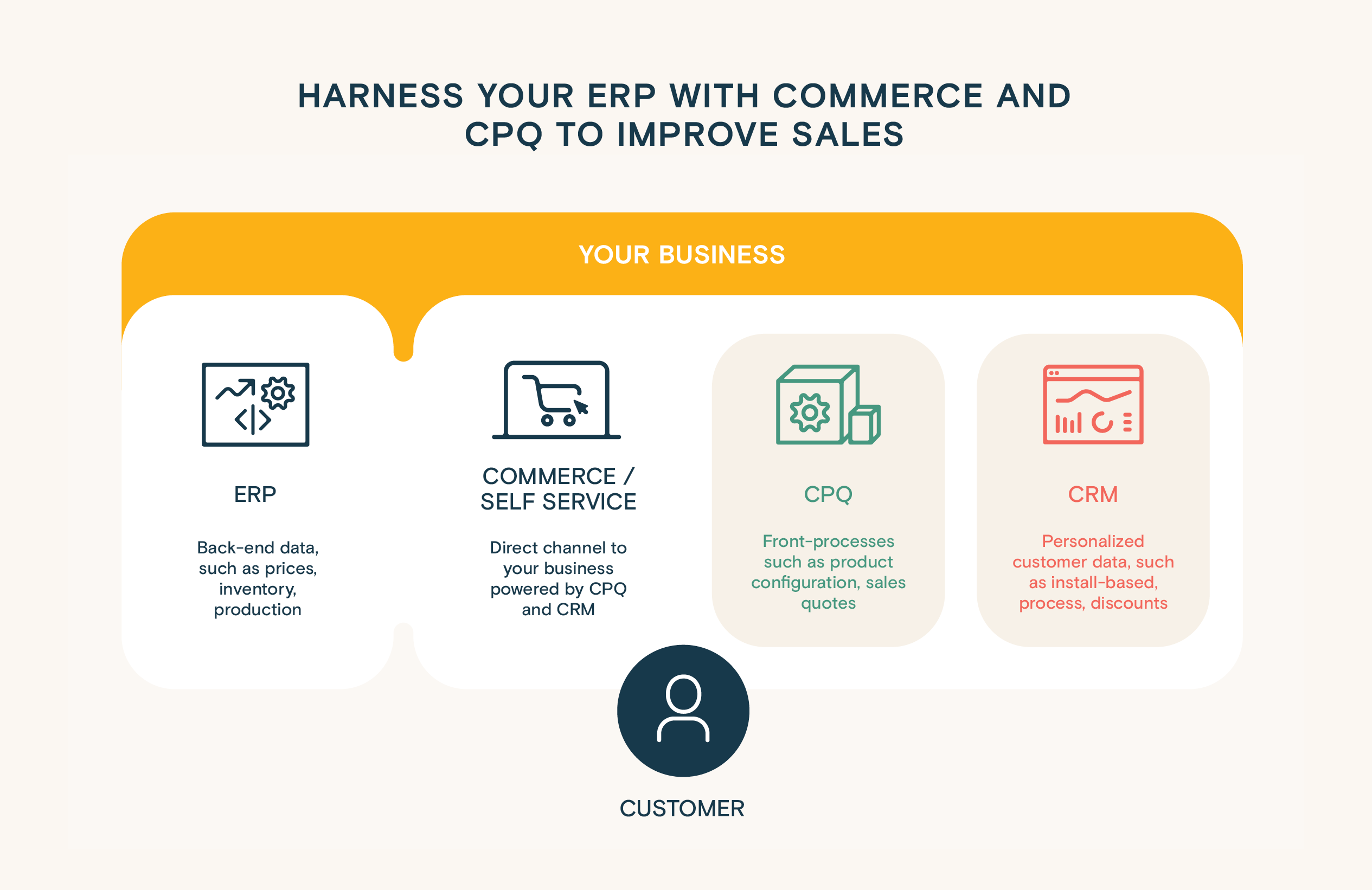
A digital sales platform brings transparency into everything your business has to offer. All your products, configurations, production requirements, and fulfillment knowledge become readily available—in a safely restricted manner—for your customers at a click of a button.
Customers and your sales teams gain visibility into real-time costs and prices. The advantage of transparency cannot be understated; it dramatically reduces order error rates and gives customers the confidence to buy quickly and consistently from you. |
Imagine your latest product innovations and marketing offers to be just hours away from the global market through your digital storefront—shortening the notoriously long time-to-market down from weeks or months. Does your sales strategy include a partner or distributor model? Manufacturers can open the same access to these businesses, extending reach into new markets or territories with the same result:
An excellent, unified customer experience that fuels business growth.
E-Commerce is paying big dividends
Manufacturers have increasingly invested in e-commerce over the years. In a Statistica report, e-commerce related shipments make up almost half of all purchases from US manufacturers. US wholesalers also got into the e-commerce act. They grew their e-commerce initiatives by more than 187% from 2000 to 2018.
back to top
Top 6 Benefits of having an e-commerce storefront for manufacturers
Like all organizations across the globe, manufacturers are scrambling to recover from the COVID-19 fallout.
Digitalization is key to an accelerated recovery.
1. Spotlight on new areas of revenue
- Manufacturing businesses are more multi-faceted than most have realized. For example, machinery manufacturers earmark machines as a primary revenue driver. However, their aftersales business unit can contribute up to 60% of the manufacturer's revenue, add up to 20% in margins, and up to 10% of wallet share through up-selling and cross-selling.
With a digital sales platform that includes e-commerce manufacturers can experiment with pay-per-use models to gain recurring revenue streams from consumables. Armed with an online storefront, OEM manufacturers can explore a direct-to-consumer strategy that complements (or replaces) their partner, dealer, or distributor strategy.
2. Accelerate speed-to-market
- E-commerce gives you direct access to your customers. And the reverse is true. This seamless two-way channel allows your latest innovations to reach your customers with minimal need for marketing campaigns or even active sales support. Promotions, new products, and new services can be in front of your customers in a matter of hours.
With a well-built e-commerce storefront, you get an intuitive user interface that is easy to navigate. An enhanced UI makes adding new content for your customers a fast and effortless process. When your e-commerce site is mobile-ready, your innovations' exposure (and their chances of being bought) gets amplified.
3. Focus on customer experience to improve top-line growth
- Your new breed of buyers is used to unprecedented access to information. As Harvard Professor Theodore Levitt put it: "People don't want to buy a quarter-inch drill. They want a quarter-inch hole."
With an e-commerce platform, manufacturers can provide personalized information that guides the customer towards their goal—that "quarter-inch hole." According to research done by Evergage, personalization can help businesses achieve measurable lifts of up to 30%. And unsurprisingly, 97% of prospects and customers surveyed expect a personalized experience.
A commerce platform that is tightly coupled with your backend systems provides speed, transparency, and accuracy that nurture trust and retention. With solid customer retention comes strong top-line growth.
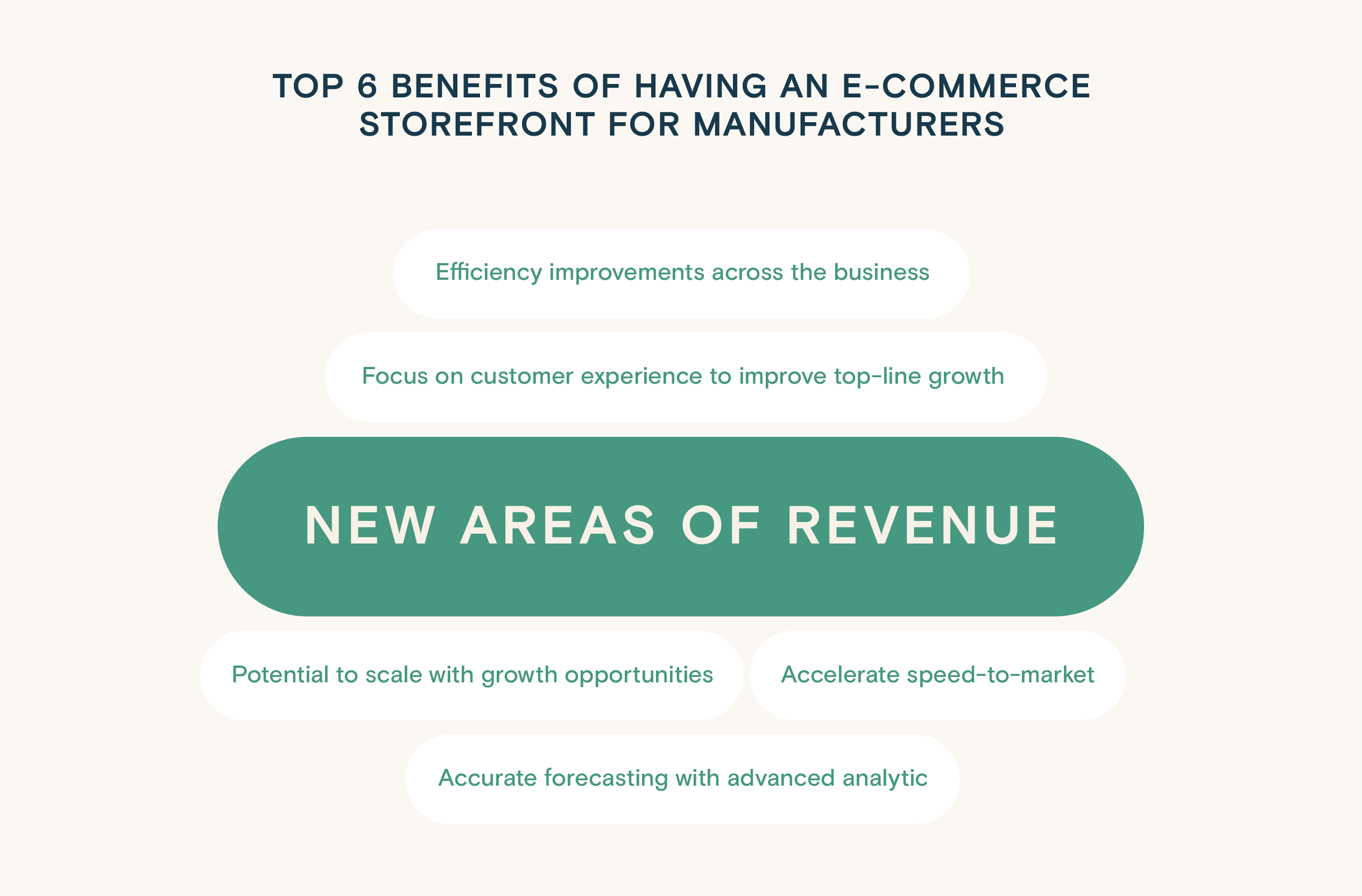
4. Efficiency improvements across the business
- E-commerce paired with your backend system improves the efficiency of several processes across the organization. Think of it as a single pane of glass, your ‘shop window,’ where customers can get real-time information instantly.
At the same time, your business has added a layer of security and customized access control. After-market products like spare parts and consumables sell themselves. With a commerce solution, you can make sure your company sells them. Customers can easily configure big-ticket items within minutes and get a penny-perfect quote 24/7 without a drawn-out sales call.
Your sales force, in return, gets a perfect overview of customer requirements and account movements. They will know precisely when to show up in person to nurture the customer or close the deal.
5. Potential to scale with growth opportunities
- As your manufacturing business is growing, so too does your audience size. Your e-commerce platform needs to scale to meet the demands of the business and its customers. A cloud-based e-commerce platform—that is part of a robust digital sales platform—scales to keep up with your business in two ways.
Firstly, it can scale in terms of features. A cloud-based platform will have new features added regularly to make it much more efficient and easier to maintain. Next, it can scale in terms of performance. As you add clients or distributors, the number of users also increases exponentially.
A cloud-based solution can be configured (on the backend) to keep up with the added volume and customization to suit every individual users' requirement.
6. Accurate forecasting with advanced analytics
- Most manufacturers struggle with accurate forecasting. Order too much raw material and you have redundant inventory—an expensive mistake. Too little means manufacturers are unable to meet demand—risking lost revenue. Order at the wrong prices—you lose your margins.
Finding the right balance during the material planning stage requires highly judicious use of data—the lifeblood of any business that wants to thrive in the era of Industry 4.0. An ideal e-commerce platform will be supported by powerful quote automation (sometimes called a CPQ; Configure Price Quote) and a communications ecosystem (or, CRM; Customer Relationship Management system).
Those features structure customer data and feed it back to the Digital Sales Platform (ERP). With high-integrity data, the analytics tools provided by the e-commerce solution can help manufacturers obtain highly accurate and actionable insights into customer behavior (site visits) and buying patterns (quote requests, volume, frequency, etc.).
Besides helping with operational decision-making, having deep intel also helps with strategic product innovation and market expansion.
Checklist: Essential commerce features for manufacturers
Industry 4.0 technologies promise to unlock hidden business value. By merging the digital and physical aspects of manufacturing, companies can gain actionable insights and create seamless workflows from the factory floor through to delivery and aftercare.
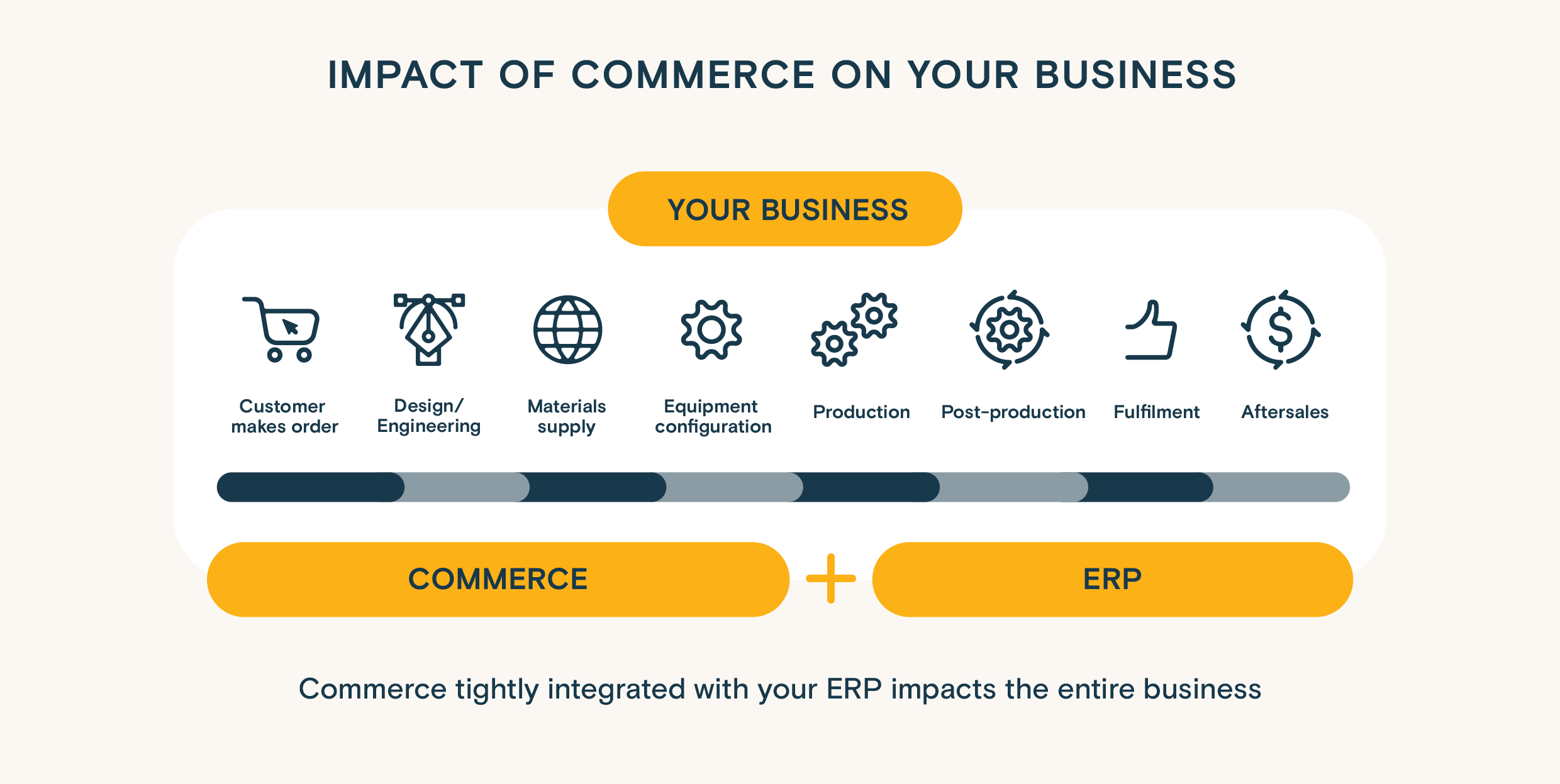
While e-commerce is simply a part of the entire process, its impact cuts across a manufacturing business's whole value chain.
Legacy systems that cannot keep pace should be replaced with solutions that can evolve to become just as deeply integrated with the business.
Whichever solution you choose, it should complement your manufacturing capabilities and take into account where your industry is headed. This long-term view allows for more efficient management of your digital business in the years to come.
 B2B manufacturing businesses will benefit from e-commerce platforms that have the following traits:
B2B manufacturing businesses will benefit from e-commerce platforms that have the following traits:
1. Is it purpose-built for manufacturing with tight integration with your ERP?
- Today, many vendors offer general-purpose e-commerce solutions. These solutions may be best-of-breed but may not be the best fit for the complexities of your business. Customization in a generalist platform can lead to a lengthy and costly implementation project. Costs incurred by system integrators, middleware, and consultancy hours, will add up as you shape the software to fit your specific needs. Every manufacturer has a unique digital transformation journey. The commerce software needs to be built for the industry and be flexible enough to adapt to each manufacturer's current and future needs. The solution will ideally support deep integrations into your backend systems (e.g., ERP) to reduce the need for expensive and frustrating workarounds that add months to the completion date.
2. Does it have the right capabilities out-of-the-box?
- Purpose-built e-commerce solutions ensure manufacturers get minimum viable product capabilities out of the box. Gain quick wins, get team buy-in, and leverage a single source of truth for customers, partners, and distributors. Connecting commerce to your ERP systems creates the foundation for a robust digital sales platform. Imagine seamless support from a CRM and CPQ that manages the terabytes of information found in your ERP and sends relevant data to the right parties. This tight integration helps keep costs, prices, and margins 100% accurate via two-way communication. It also keeps the business in complete control whether customers buy directly via your digital commerce platform or your sales team.
3. Is it built in the cloud and delivered online as Software-as-a-Service?
- One misconception that many manufacturers have is that e-commerce is a costly, resource-heavy upgrade they do not need. That may have been the case a decade ago. Cloud-based commerce solutions receive frequent updates that pose little to no disruption risks to a manufacturer's operations. These SaaS solutions enable manufacturers to focus on innovation and worry less about the nuts and bolts of the sales process. Cloud-based solutions also have the agility (via a microservices-based architecture) and scalability necessary to keep up with continually evolving business needs and customer expectations. Leading solution providers are also modular, making them flexible enough to connect seamlessly with existing systems and be a powerful front-facing system for your sales process.
4. Has it been designed to fully enhance the user experience?
- Technology is tied to improving efficiency. But are you improving in the right areas? Manufacturers must view problems from the customer's perspective. Your customers want to buy, and the faster, the more accurate, the better. Your e-commerce solution needs to harness the complexity of the business yet be simple to navigate and use. The ability to personalize each user's experience is key to customer retention and long-term commercial success. Having an integrated CRM can give manufacturers an overview of sales progress for individual customers—along with location, buying behavior, decision-makers, and so on—and provide insights that help improve customer satisfaction.
Top 3 tips to prepare your business for digital Commerce
Manufacturers who have started the journey of digital transformation have difficulty balancing traditional manufacturing processes with emerging Industry 4.0 technology. Without a roadmap, the journey can be longer and more painful than the transformations in other industries.
This anticipated slow pace of transformation is another reason many businesses delay their transformation until they find an "opportune moment." However, the exponential speed at which the market is evolving puts those who wait further and further behind. To maintain a competitive edge, manufacturers need to take decisive action forward. Today.
While transformation is a journey, manufacturers need to avoid the scenic route. Time-to-value is a key advantage that helps lower costs and opens up your business to customers faster. |
1. Adopt next-generation systems built for industry requirements
Of all the Industry 4.0 technologies, manufacturers need to pay close attention to "cloud computing." Manufacturers with cloud-based ERPs have significant advantages, including the ease of integrating powerful applications like a CRM or CPQ.
To further reduce time-to-value, In Mind Cloud includes these functions as part of a complete digital sales platform.
Manufacturers still using traditional ERPs—characterized as having a large number of applications, limited integration, and interoperability—may find it almost impossible to adopt e-commerce even if they wanted to.
Their ERP systems are heavily customized, extremely complex, and slow to deploy. If that is your situation, the ERP becomes a sunk cost and ceases to be an asset. It has become a liability that needs to be shed in favor of a more lightweight, more flexible, and faster next-generation cloud-based platform—which also happens to be future-proof.
2. Use integrated Software-as-a-Service to enhance business speed and agility
Many businesses look at implementing an e-commerce platform as a project. Getting things to run faster takes a slight change of perspective. Instead of a project, manufacturers are, in reality, taking on a software-as-a-service (SaaS) solution that is deeply integrated with their backend systems.
From this viewpoint, your e-commerce platform's value generation does not end when it is up and running. That’s because cloud-native e-commerce SaaS platforms come with compounding benefits.
-
Reduced time-to-value
- Speed is the primary advantage of SaaS. It eliminates the need for on-premise hardware, installation and requires minimal configuration. In manufacturing, however, some integration is still necessary. But with powerful APIs and microservice architecture, businesses can implement e-commerce capabilities in weeks instead of months (or more).
-
Reduced total costs-of-ownership
- Lower costs are a direct result of fast implementation. Compared to a traditional model, SaaS-based commerce platforms are not resource-hungry. No hardware means no acquisition or maintenance costs. No installation means no licensing fees, or any other hidden costs incurred from a lengthy, drawn-out implementation or future upgrades.
-
Powerful integration and scalability
- Manufacturing e-commerce platforms are built with integration in mind. It means the software has integration APIs built-in and is ready to connect to leading backend systems quickly. Since SaaS e-commerce platforms are built-in cloud environments, manufacturers also benefit from scalability—and only pay for the resources they use and nothing else.
-
Designed to be easy to use
- SaaS e-commerce platforms are built with the user in mind. In manufacturing, sales can get extremely complicated. The best manufacturing-focused e-commerce platforms hide that complexity and present the information neatly in a highly controlled, user-friendly interface that even the most non-technical buyer can navigate with ease.
3. Assemble a dedicated e-commerce team to ensure digital initiative success
Your e-commerce store is the digital face of your business.
From this perspective, your digital store becomes a high-priority business initiative. The objective here goes beyond merely launching a website where customers can buy and make orders. Its success depends on the commitment your business can afford. And that means assembling an e-commerce team on day one. This team will be responsible for keeping things on track, ensuring objectives are met, and assessing progress.
Ideally, the same team is also responsible for your digital storefront after its launch. You may even need to expand this team to include members that provide support for your customers. These members can consist of sales, customer service reps, account service, and technical support reps.
How to get up and running in 3 months (or less)
As mentioned, setting up a team responsible for your e-commerce initiative is critical to its success. Your team will help the initiative stick to the implementation timeline and prevent costs from spiraling out of control.
These are important quick wins for the team, and your business.
For the best results, we’re providing an overview of the implementation methodology that has benefited In Mind Cloud customers.
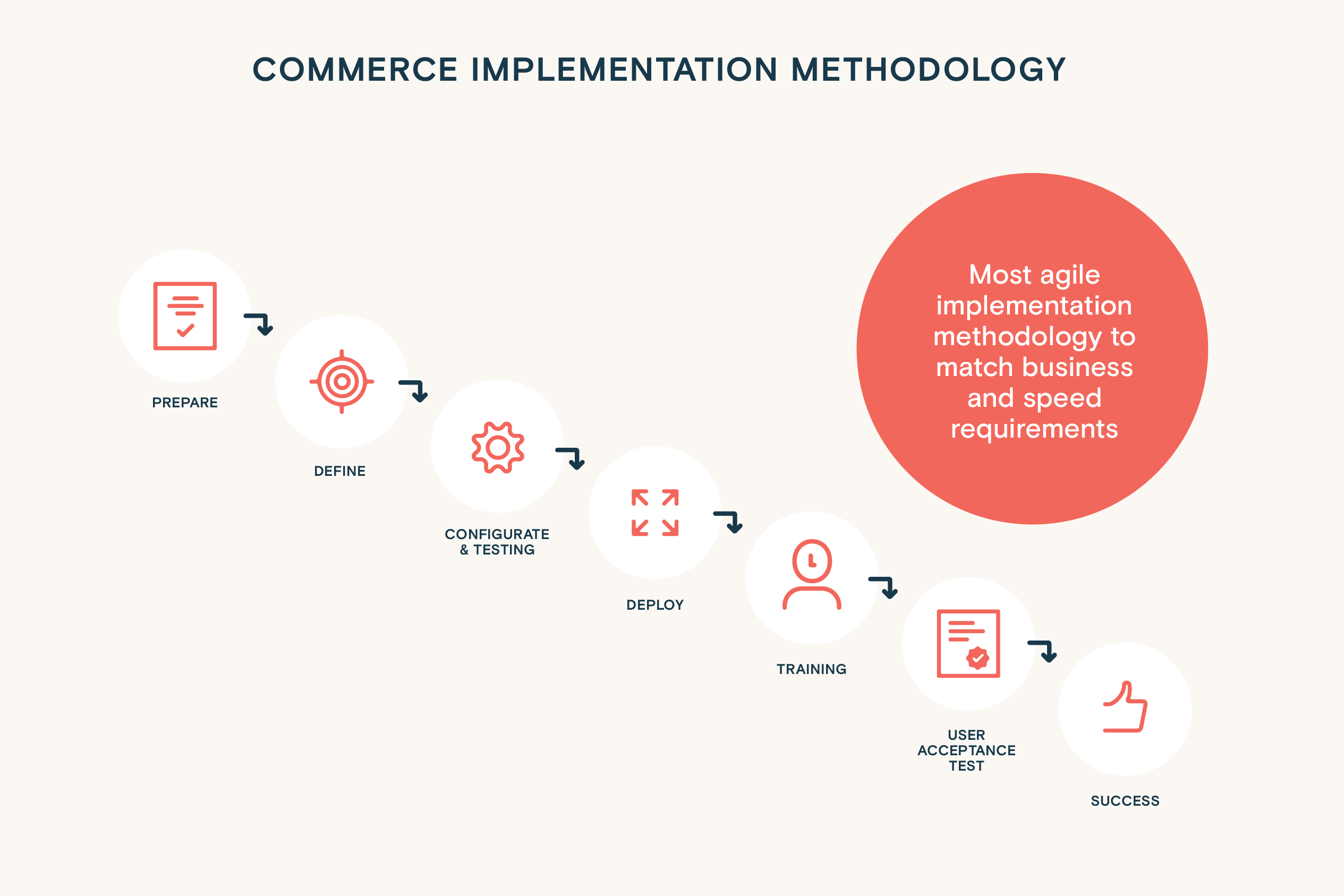
The implementation model we recommend is based on an agile methodology. This approach can help manufacturers get their e-commerce system live in 12 weeks or less.
Every manufacturer has unique IT and data environments. To overcome this challenge, manufacturers can take advantage of a software vendor’s out-of-the-box integrations and best-practices to shorten implementation time. |
If your digital commerce vendor has extensive experience with implementing commerce solutions for manufacturing companies, it’s possible to send your digital commerce solution live in less than 12 weeks.
How Satisloh uncovered a goldmine with digital commerce
| Company: |
Satisloh AG A member of the Essilor Group |
| Industry: | Mechanical Engineering |
| Products: | Machines for the ophthalmic and precision optics industry |
| After-sales: | Consumables, tools, spare parts, support services |
| Headquarters: | Baar, Switzerland |
| Subsidiaries: | 10 |
| No. of employees: | 950 |
| Revenue: |
€100 Million Euro
|
Satisloh AG relies on In Mind Cloud's Digital Sales Platform to streamline and reduce errors in their global sales processes. The platform helped the company yield tremendous benefits through more accurate quotes and a 30% reduction in lead times through better forecast accuracy.
Once the system was in place, Satisloh was ready to take the next step on their digitalization journey: Providing an end-to-end buying experience through commerce features. Satisloh’s goal is to provide the best possible customer experience and to increase its after-market revenue.
Satisloh aims to provide customers with a hassle-free way to buy consumables and spare parts—even if they don't own Satisloh machines. They shall be able to serve themselves with information, inquiries or direct purchases 24/7, without the engagement of service or sales representatives. |
For Satisloh, this is a natural progression. Their after-sales business already contributes to almost 60% of their total revenue. However, giving existing or even new customers 100% self-serve access to their business is no small feat.
Satisloh needed a cutting-edge commerce solution that fully integrates with its ERP system that is already enhanced by In Mind Cloud's CPQ. By focusing on the after-sales business, Satisloh expects their e-commerce initiative to drive an additional 20-30% in revenue for the company.
Their estimated revenue increase does not even include the tangible (repeat business) and intangible (higher satisfaction and loyalty) gains provided by offering top-tier customer service.
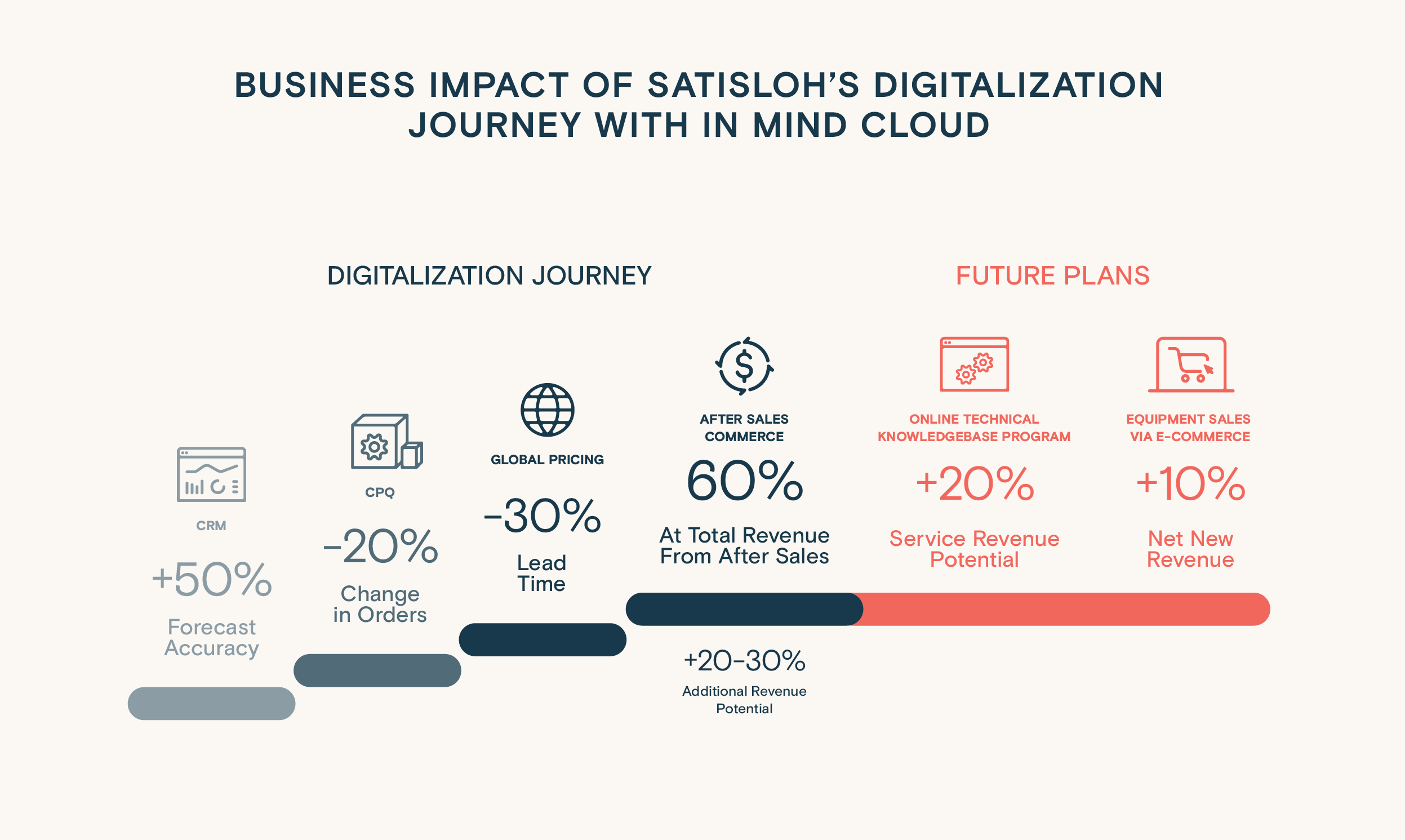
Conclusion: Meet your customers where they are
Like Satisloh, many manufactures have embraced digital commerce with great success. Your customers are increasingly turning to online channels to buy what they need. And the COVID-19 pandemic has accelerated this need five years ahead of forecasts by analysts.
Manufacturers that have yet to keep pace, are increasingly lagging behind their peers in this highly lucrative space. Take B2C retail giant like Amazon for example. Armed with a superior technology, industry-leading buying experience, and global reach, Amazon is starting to provide B2B customers with access to almost everything they may need. |
In other words, they are inserting themselves between your business and your customers.
What e-commerce giants cannot replicate, however, is your manufacturing expertise. And more importantly, your personal relationship with your most loyal customers.
While you may not be able to level the playing field completely, your business still holds several key advantages that your own digital commerce platform can amplify.
The stage is set. Your customers are ready for e-commerce, and so is your business. It is now time to meet them where they are.
Your customers are waiting for a better way to buy from your business. Download the Manufacturing Commerce Playbook for offline reading, or to build a case to convince stakeholders that now is the time to invest in digital commerce for manufacturing.

 Deutsch
Deutsch



